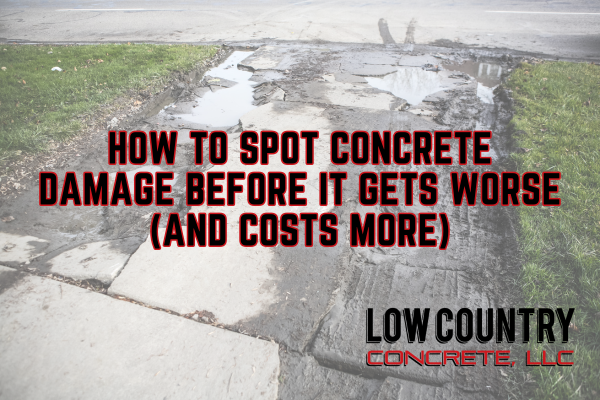Concrete is known for its strength and durability, but even the toughest materials need care—especially in our coastal southern climate where high humidity, salt air, and heavy rainfall can speed up wear and tear. Ignoring small issues in your concrete today could lead to major repairs (and major costs) tomorrow. The good news? You can prevent most of that with early detection and regular maintenance, and Low Country Concrete is here to help.
In this guide, we’ll break down how to spot concrete damage before it gets worse—and offer simple, actionable tips for keeping your surfaces in top shape year-round.
1. Cracks: The First Red Flag
Hairline cracks may not seem like a big deal, but they’re often the first sign that your concrete is under stress. In coastal climates, moisture can seep into these cracks and, combined with salt air, lead to faster erosion or rusting of any embedded metal (like rebar).
What to Look For:
- Thin, spiderweb-like cracks on the surface
- Cracks that grow or widen over time
- Cracks near joints, edges, or areas with pooling water
What to Do:
Seal small cracks early using a concrete crack filler. For larger or growing cracks, call in a pro to assess structural concerns.
2. Surface Discoloration or Staining
Concrete naturally lightens as it cures, but dramatic discoloration can be a warning sign—especially if you notice dark patches or white, powdery residue.
What to Look For:
- White, chalky buildup (efflorescence) caused by water pushing salts to the surface
- Rust stains, often indicating metal corrosion underneath
Mold or mildew growth, common in humid environments
What to Do:
Clean surface stains with a concrete-safe cleaner. If discoloration keeps coming back, investigate for underlying water drainage or moisture problems.
3. Spalling (Flaking or Chipping Concrete)
Spalling is when the surface of the concrete starts to chip, flake, or peel away. It’s common in coastal climates because salt and moisture can break down the cement binder over time.
What to Look For:
- Pitted or rough spots on driveways or patios
- Areas where small chunks are missing
- Exposed aggregate or crumbling edges
What to Do:
If caught early, you can resurface spalled concrete. If it’s deeper, a professional patch or replacement may be needed. Prevent future spalling with a high-quality sealer designed for coastal use.
4. Uneven Surfaces or Sinking
Shifting or sinking concrete isn’t just a cosmetic issue—it can be a sign of foundational problems or water-related erosion beneath the slab.
What to Look For:
- One section of a sidewalk or patio lower than another
- Tripping hazards or visible gaps
- Pooling water in certain areas
What to Do:
Have a professional assess the issue. They may recommend slab jacking (lifting sunken concrete), improving drainage, or replacing the slab if the damage is extensive.
5. Rusting Rebar or Exposed Reinforcement
In coastal areas, saltwater exposure can cause reinforcing steel (rebar) inside concrete to rust. As rust expands, it puts pressure on the surrounding concrete, leading to cracking and spalling.
What to Look For:
- Brown or orange streaks on the surface
- Visible metal near cracked areas
- Bulging or raised concrete patches
What to Do:
This is one issue that should always be addressed by a professional. Once rebar starts rusting, the damage can accelerate rapidly.
6. Moisture Problems: Standing Water & Poor Drainage
Concrete needs proper drainage to perform well. If water regularly pools on or near your surfaces, it can seep into cracks and accelerate decay—especially during heavy spring and summer storms.
What to Look For:
- Standing water after rain
- Mold or mildew near edges
- Damp patches or efflorescence
What to Do:
Grade the area to improve water runoff or install drainage solutions. A water-repellent sealer can also help protect the surface.
Preventative Tips for Coastal Concrete Longevity
Now that you know what to look for, here’s how to stay ahead of the damage curve:
- ✅ Seal Every 2–3 Years: Use a high-quality concrete sealer that protects against moisture and salt.
- ✅ Clean Surfaces Regularly: Remove dirt, salt, and mildew to reduce surface stress.
- ✅ Address Cracks Early: Don’t let them expand—seal them ASAP.
- ✅ Inspect After Heavy Storms: Especially after hurricanes or tropical storms.
- ✅ Hire a Pro for Annual Inspections: Especially for larger slabs, patios, and foundations. Low Country Concrete will provide a quote right away.
Low Country Concrete: Your Partner In Preventative Maintenance
Concrete damage doesn’t happen overnight—but it can sneak up on you if you’re not paying attention. By catching early signs like cracking, spalling, or discoloration, you can avoid costly repairs down the road.
In a humid, salt-rich southern climate, prevention is key. Regular maintenance, inspections, and smart material choices will go a long way in extending the life and beauty of your concrete.
If you’re unsure about what you’re seeing, don’t wait—reach out to us for an evaluation. A little professional input today could save you thousands tomorrow.


Recent Comments